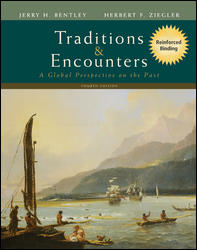Traditions and Encounters, 4th Edition (Bentley)Chapter 16:
INDIA AND THE INDIAN OCEAN BASINOverviewDuring the postclassical period there emerged in India no long-lasting imperial authority, as there were in China and the Islamic world. Regional kingdoms were the norm. Nevertheless, Indian society exerted a profound influence on the cultures of south and Southeast Asia. Through the extensive trade networks of the Indian Ocean basin, Indian forms of political organization, religion, and economic practices spread throughout the region. Several developments in India during this era gradually spread throughout the larger culture zone. - Dramatic agricultural growth fueled population growth and urbanization. These phenomena, combined with specialized industrial production and trade, resulted in unprecedented economic growth for the region.
- India's central position in the Indian Ocean basin resulted in it becoming a major clearinghouse for products of the voluminous maritime trade network that encompassed east Africa, Arabia, Persia, Southeast Asia, and Malaysia as well as the entire Indian subcontinent.
- Islam originally appeared in India through a variety of conduits, and it eventually became the primary religion of one quarter of the population. From India, Islam, along with Hinduism and Buddhism, spread to Southeast Asia and the nearby islands.
 | 
















